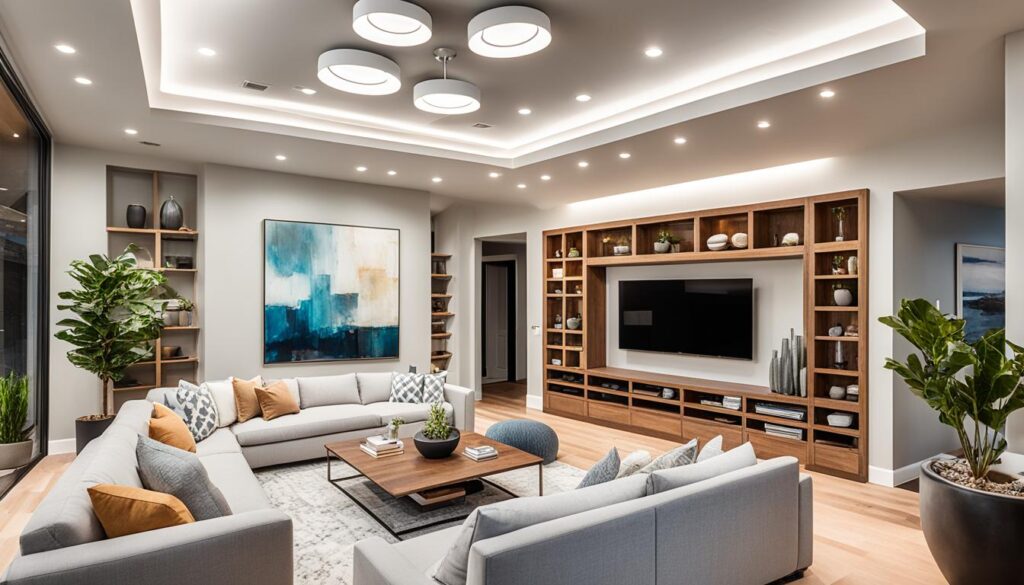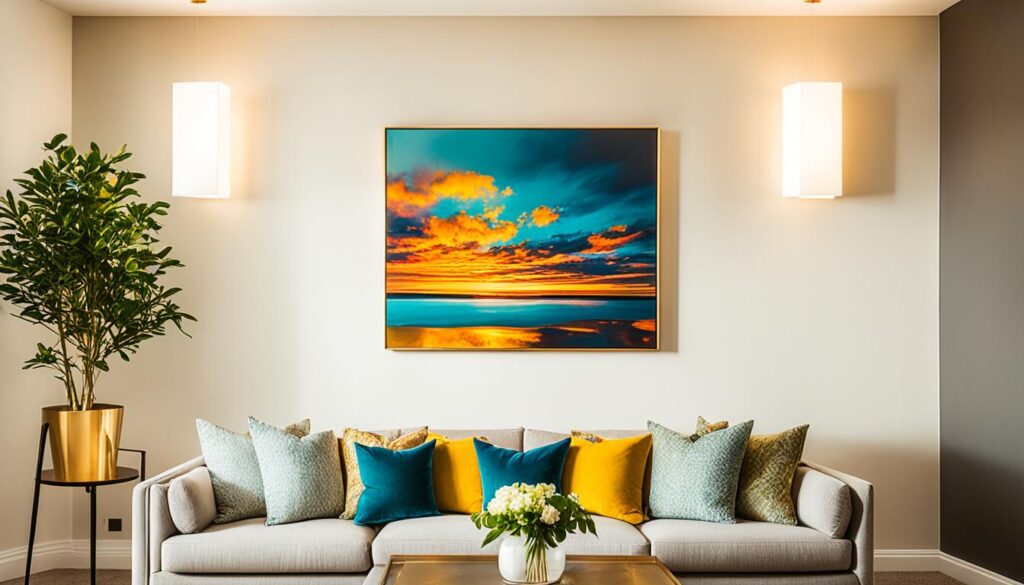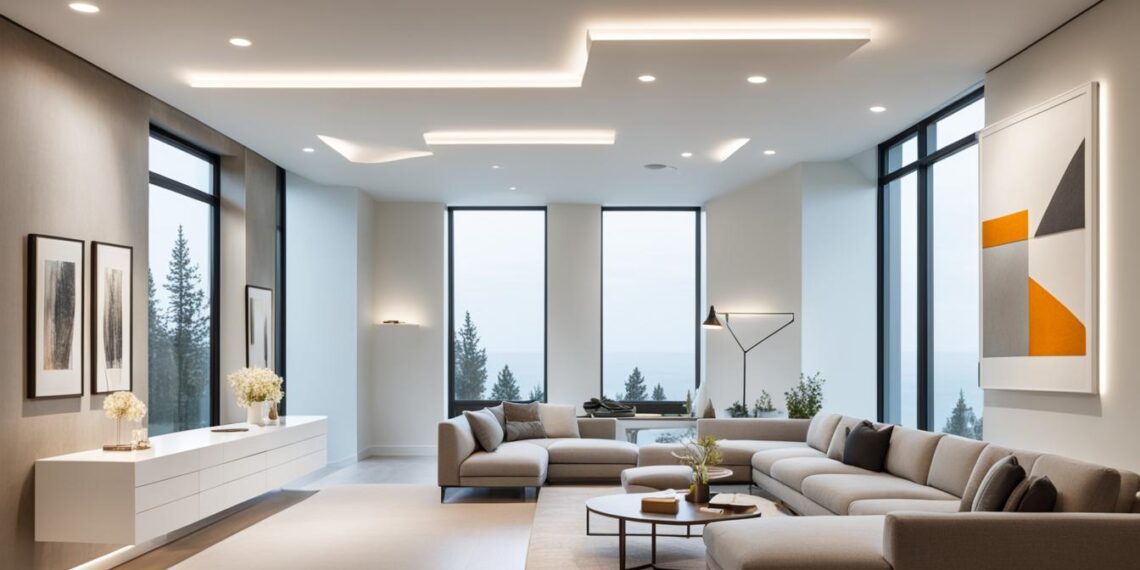Have you ever felt instantly calm walking into a room? Often, it’s the lighting that makes you feel so welcomed. Recessed lighting can change not just a room but also how we feel inside it. In modern homes, designing with recessed lighting is key. It’s not just about lighting up a space. It’s about creating a place that feels right to your soul. This guide will show us how to make our homes look and feel beautiful and warm with recessed lighting.
Key Takeaways
- Recessed lighting design enhances the overall aesthetic of modern homes.
- Thoughtful layout can create a balance between ambiance and task lighting.
- Choosing the right fixtures significantly impacts both appearance and functionality.
- Understanding color temperature is crucial for achieving the desired mood.
- Proper spacing of recessed lights ensures optimal lighting without clutter.
- Adjustability in fixtures allows for versatility in lighting design.
Understanding Recessed Lighting
Recessed lighting is also called pot lights or can lights. It includes fixtures that are installed in the ceiling. This setup creates a sleek, modern look because it doesn’t stick out into the room. People often pick these lights because they fit well with many decorating styles. They can be used in different areas of the home.
When you’re thinking about adding recessed lighting, it’s important to look at all the choices. Some of the main types are:
- New construction housing (for ongoing builds)
- Remodeling housing (for existing homes)
- Adjustable fixtures (for directing light as needed)
- Baffle trims (to reduce glare)
One big plus of recessed lighting is how energy-efficient it is. Many use LED technology, which saves a lot of energy. This is good for the planet and your utility bills. With so many designs, it’s easy to find lights that go with your home’s style.
| Fixture Type | Purpose | Best For |
|---|---|---|
| New Construction | Installed during building | New homes or major renovations |
| Remodeling | Added post-construction | Existing spaces needing updates |
| Adjustable | Flexible lighting direction | Highlight artworks or features |
| Baffle Trims | Minimize glare | Living areas and bedrooms |
Knowing about recessed lighting can make a big difference in your home’s lighting. Good planning when installing these lights can make your space look great. It will also be more functional.
Benefits of Recessed Lighting in Modern Homes
Recessed lighting is popular in today’s home design for many reasons. It lights up a room evenly, making it feel welcoming. This even light makes rooms look bigger and more open.
These lights bring a sleek, modern look since they don’t clutter spaces like traditional fixtures. They’re installed flush to the ceiling, offering a clean look. This allows more wall space for art or furniture.
Recessed lights are also energy savers, especially when you choose LED options. They use less power and last longer than other lights. This means you save money on energy bills and spend less on replacements.
The following table outlines why recessed lighting stands out as an optimal choice for modern homes:
| Feature | Benefits |
|---|---|
| Uniform Illumination | Enhances ambiance and makes spaces feel larger. |
| Aesthetic Appeal | Minimizes clutter and complements diverse styles. |
| Energy Efficiency | Reduces utility bills and promotes sustainability. |
| Flexibility | Allows for varied installation in different settings. |
Choosing the Right Recessed Lighting Fixtures
Finding the perfect recessed lighting fixtures is important for your home’s ambiance. There are many shapes, sizes, and finishes to choose from. Homeowners can match their style and needs. Modern recessed lighting is versatile and fits almost any room.
When picking recessed lighting fixtures, think about these points:
- Lighting Needs: Decide if you need ambient, task, or accent lighting. Kitchens might need bright task lighting. Living rooms usually look better with soft ambient light.
- Fixture Shapes: There are round and square shapes, and custom designs. Pick one that goes with your home’s look.
- Sizes: Big fixtures make a statement, small ones are subtle. The right size depends on your space’s dimensions.
- Finishes: Choices like chrome, matte black, or brass affect the look. Choose a finish that fits your room’s style.
- Color Temperature: Different temperatures can change a room’s feel. Warm tones are cozy, cool tones are good for work areas.
- Dimmers Compatibility: Not all fixtures work with dimmers. Check this if you want to adjust the light’s brightness.
Taking time to review these factors helps you find the best recessed lighting. The right choice adds beauty and function to your home. It makes each room feel just right.
Recessed Lighting Design: Key Considerations
When designing a modern home, color temperature is key. It’s measured in Kelvin (K) and affects the room’s mood. Choosing the right color temperature makes your lighting both beautiful and practical.
Color Temperature and Its Importance
Different color temperatures change a room’s atmosphere. Here’s a simple guide:
| Color Temperature (K) | Description | Best Use |
|---|---|---|
| 2700K – 3000K | Warm white light | Living rooms, bedrooms |
| 3500K – 4100K | Neutral white light | Kitchens, bathrooms |
| 5000K – 6500K | Cool white light | Offices, workspaces |
Warm tones are perfect for relaxing areas. They make rooms cozy for downtime. On the other hand, cool tones keep you focused. They are great for spaces where you work or study.
Matching Bulb Types for Harmony
To get a unified look, use the same type of bulbs. Here’s what to think about:
- Style: Make sure the bulbs fit your design.
- Brightness: Keep the brightness the same in all lights.
- Color Rendering Index (CRI): Choose bulbs with a CRI over 90 for true colors.
These tips will help blend your recessed lighting with your home’s overall style.
Planning Your Recessed Lighting Layout
When you design a recessed lighting layout, it’s important to know what kind of lights you need. Your home has different areas that do different things. A good plan mixes general, task, and accent lighting to make each space work better.
General Lighting vs. Task Lighting vs. Accent Lighting
General lighting makes sure a room is bright enough for everyday tasks. On the other hand, task lighting shines extra light on places you need it, like where you read or work. Accent lighting adds style by spotlighting special features or decorations.
Keep these ideas in mind while planning your lighting:
- General lighting: Place fixtures to light up the whole room evenly.
- Task lighting: Put lights close to where you need more light for working.
- Accent lighting: Choose adjustable lights to highlight art or important features.
Guidelines for Spacing Recessed Lights
Getting the spacing right is key for a good lighting layout. Follow these tips for a balanced setup:
| Room Type | Recommended Spacing (feet) | Fixture Wattage |
|---|---|---|
| Living Room | 6-8 | 16-20W |
| Kitchen | 4-6 | 20-30W |
| Bedroom | 8-10 | 12-16W |
Keep these spacing guidelines in mind. This will help you choose the right lighting for each room. By knowing the difference between general, task, and accent lighting, you can design a setup that suits every room’s needs.
Recessed Lighting Spacing Guidelines
Effective recessed lighting makes any room warm and welcoming. To get light everywhere and avoid shadows, the right spacing is key. Here’s how to figure out the best distance between your lights, taking into account ceiling height.
Recommended Distance Between Fixtures
The right space between recessed lights depends on the room size and the light spread you want. A simple guide to follow is:
- For 8-foot ceilings, space recessed lights around 6 to 8 feet apart.
- For 9-foot ceilings, go for 8 to 10 feet between lights.
- With 10-foot ceilings, you can space them 10 to 12 feet apart.
Keeping these distances helps light the room well and cuts down on dark areas in big spaces.
Adjustments for Ceiling Height
Changing ceiling height affects where lights should go. Higher ceilings mean adjusting lights to stay closer for good floor lighting. Though it might seem like you should space them farther apart, closer is better. It gives off a nice, even light and stops shadows.
If your ceilings are different heights, try adjustable fixtures. They let you keep the light even, no matter the ceiling’s height.

Recessed Lighting Installation Tips
Starting with recessed lighting installation means knowing your wires. Planning ahead and being safe is key to good lighting. Whether you do it yourself or get professional help, understanding the basics is important.
Understanding Wiring Requirements
Wiring is key for lighting installation. Always check your local electrical rules first. You’ll need:
- The right wire size for your lights and circuit.
- A special circuit for the fixtures to avoid overloads.
- Proper grounding to reduce the risk of shocks.
Regular checks and following rules keep things safe and working well.
Obtaining Professional Assistance
Some homeowners might want to install lights themselves. But getting a pro can save time and money. An expert electrician will make sure:
- Your setup meets local electrical standards.
- All wiring is done correctly and safely.
- They fix any old electrical problems.
Getting help from a professional makes your lighting better and more dependable.
Enhancing Aesthetic Appeal with Recessed Lighting Trim
The trim of recessed lighting fixtures is key to any space’s look. Various options can change a room’s vibe. It’s important to match trims with your decor for a unified look.
Choosing the Right Trim for Your Style
Your personal style and the feel you want are crucial in picking recessed lighting trim. Let’s look at some styles:
- Reflective Trims: These boost brightness, great for modern areas.
- Baffle Trims: They cut down on glare, making spaces warm and welcoming.
- Wet-Rated Trims: Best for bathrooms or kitchens, where safety meets style.
Each trim style adds something special to a room. It’s important to choose ones that match your design ideas.
Considerations for Adjustability
Adjustable trims offer versatility in lighting angles. Key points to think about include:
- Flexibility: Opt for trims that pivot or tilt, perfect for spotlighting art or features.
- Light Diffusion: Consider how trims spread light and affect its quality.
- Compatibility: Make sure your trim fits well with your lighting setup.
Choosing the right trim not only boosts a room’s look but also its lighting function. By selecting carefully and considering adjustability, you can enhance your home’s interior design.
Accent Lighting Ideas for Highlighting Art and Features
Accent lighting is key to showing off artwork and unique features in a home. The right accent lighting ideas help create focal points. They also make textures look more appealing.
Use recessed lighting near art to spotlight it in a beautiful way. This method highlights your decor and improves the look of your space. Keep these tips in mind for the best light placement:
- Position lights at a 30-degree angle to avoid glare and enhance color depth.
- Utilize adjustable trims to direct light precisely where it’s most effective.
- Combine multiple fixtures to create a layered lighting effect that adds depth to walls.
When highlighting features like wall panels or sculptures, think about the light type and color. Warmer tones create a cozy feel, while cooler tones give a modern touch. Dimmers change the mood for different events.
Try these ideas to make your space more interesting. Smart accent lighting doesn’t just impress guests. It turns your home into a welcoming art gallery.

Dealing with Common Challenges in Recessed Lighting Design
Recessed lighting can make a room look beautiful. But, it has challenges like glare, uneven light, and poor color. Knowing how to deal with these can make your lighting perfect.
Glare from lights can be annoying. To fix this, change where your lights are or use softer lights. Putting recessed lights at the right spot reduces glare too.
Lighting that’s uneven can ruin the look of a space. Plan your light placement well. Use different kinds of lights to make the room light up evenly.
Colors can look off with bad lighting. Use LED bulbs that show true colors. Trying different bulbs and lights can solve color issues.
- Implement dimmers for adjusting brightness
- Choose fixtures that fit the space and purpose
- Combine recessed lighting with other types of lighting for better balance
If you know these lighting issues and how to solve them, you can make your home warm and welcoming.
| Challenge | Lighting Solution |
|---|---|
| Glare | Adjust layout or use diffusing fixtures |
| Uneven Lighting | Strategic planning with ambient and task lighting |
| Poor Color Rendering | Use high-CRI LED bulbs |
Maintaining Flexibility with Control Zones
Creating control zones within recessed lighting design offers great lighting flexibility. With separate areas for lights, homeowners can adjust their spaces to their liking. Whether it’s for dinners or parties, settings can boost the mood perfectly.
A smart plan for control zones allows you to:
- Adjust light levels in different spots for personalized brightness.
- Mark off unique spaces in open areas, making them look better.
- Save energy by lighting only needed zones.
To manage control zones well, using smart dimmers and switches is key. These gadgets make it simple to change lighting to fit any moment. They help you focus when working or relax in the evening. This lighting flexibility changes the space for any activity or mood.
Conclusion
Effective recessed lighting is key for modern homes. It improves both function and look. Placing lights wisely not only lights up spaces well but also brings in elegance and style.
Choosing energy-saving options helps lower bills. It lets homeowners create well-lit areas that suit their lighting needs perfectly.
We talked about the benefits of recessed lighting like smooth illumination and design flexibility. We also looked at ways to customize it. Plus, we tackled common problems and gave smart solutions for a stylish and efficient setup.
Spending time on your recessed lighting design can really change your living areas. Use the advice given here for a perfect mix of good lighting and modern design. This will make your home brighter and more welcoming.








